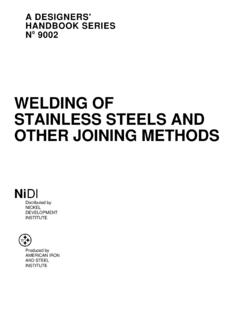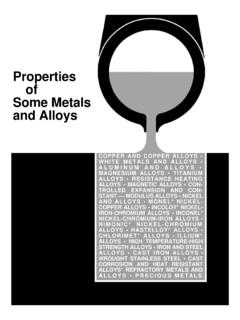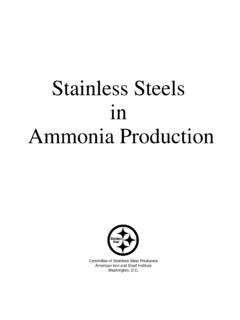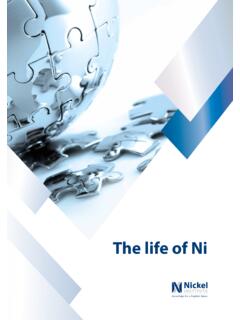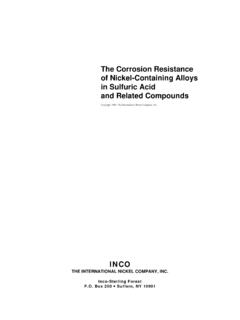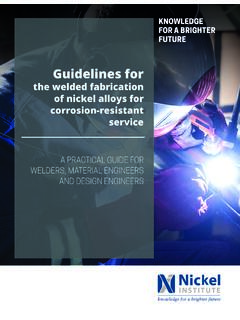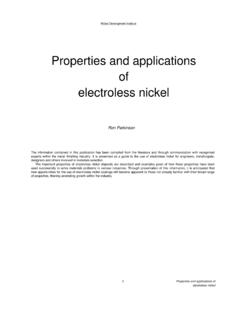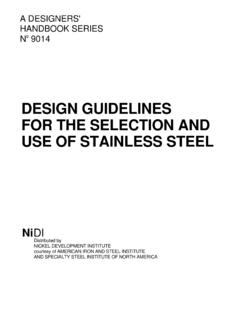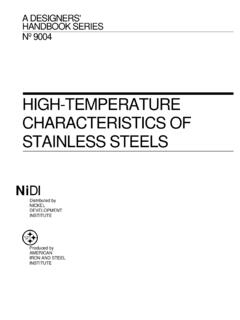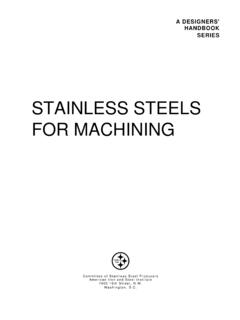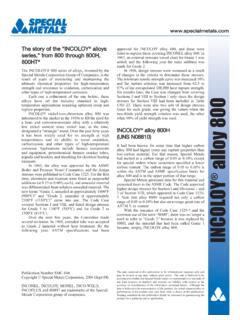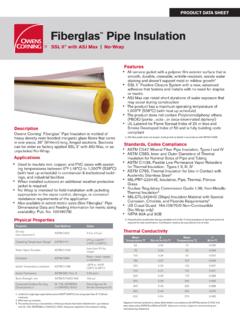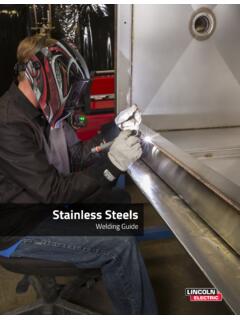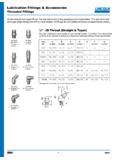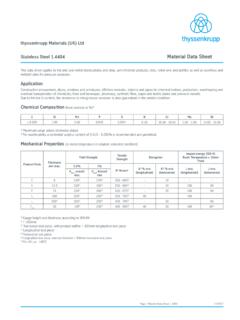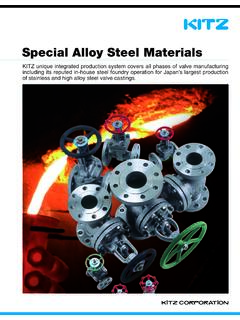Transcription of Ni-Hard - Nickel Institute
1 Ni-Hard Material Data and Applications For over half a century, Ni-Hard has been the number one choice for industrial processes demanding extreme abrasion resistance. Its well proven, low-cost characteristics have seen it used in the mining, power, cement, ceramic, paint, dredging, coal-coke, steel and foundry industries. As grinding balls, mill liners, pulverizer rings and roll heads, slurry pump parts, pipes and elbows, wearbacks and metalworking rolls . the range of properties inherent in the different grades of Ni-Hard has made it a worldwide success. This book updates information for users on Ni- hard 's material data and applications. Contents Introducing Ni-Hard 2. Abrasion resistance Carbon content and microstructure Resistance to fracture Grades and compositions 6. Standard Ni-Hard 1 & 2. special Ni-Hard 1 & 2. Ni-Hard 4. Production 14. Moulding and methoding Melting Casting Bi-metallic and compound castings Heat treatment Finishing the castings Welding Machining Machining Properties 24.
2 Testing the castings 26. Standards Bibliography 28 BRAGONZI, LONATE POZZOLO, ITALY. Introducing Ni-Hard Ni-Hard is the generic name for a family of white cast irons alloyed with Nickel and chromium to give high hardness and outstanding resistance to abrasion. There are two distinct groups of Ni-Hard compositions: the medium alloyed Ni- hard 1 and Ni-Hard 2 with, nominally, (resp ) C, 4% Ni, 2% Cr Ni-Hard 4 with, nominally, 3% C, 9% Cr, 5% Ni, 2% Si. These three alloys are standardized in almost all industrialized nations under various designations. SCHW BISCHE H TTENWERKE, K NIGSBRONN, GERMANY. Machined rollers for the clay and brick industries in Ni-Hard 1 and Ni-Hard 4. 2 Ni-Hard Abrasion resistance resistance of white irons changes with Carbon content and the ratio of metal to abrasive hardness. microstructure The abrasion resistance of a material is not a distinct property like hardness or At a high ratio, abrasion resistance is The abrasion resistance of iron and tensile strength, but depends on the high, but when the ratio drops below steel correlates reasonably well with system where abrasion takes place.
3 There is a wide scatter and the their carbon content and This so-called tribological system is slope of the curve indicates the microstructure. Generally, abrasion complex: subtle changes may result in decreasing influence of metal resistance will increase with carbon significant changes in service life or hardness. Unfortunately, many content, provided free graphite is relative performance of different minerals contain quartz or silicates absent. The results in Figure 3 indicate materials. which are as hard or harder than a dramatic increase in abrasion metallic alloys. But even when the resistance with carbon content, from Abrasion resistance cannot be easily abrasive is harder than the metal, low carbon steels to white irons. measured. The many abrasion tests increasing metal hardness can still be used or described in the literature do beneficial as shown in Figure 2. The At each carbon level, the highest provide valuable insights into the wide scatter band in both figures abrasion resistance is achieved by mechanisms of abrasion, but their indicates that other factors play a role.
4 Materials with martensitic matrix results do not allow a calculation or structures. Their position within the prediction of service. Such tests may There is a much closer correlation if the hardness of the worn and work scatter band depends on the heat be useful tools in research and hardened surface, instead of the treatment condition: untempered development of improved abrasion, original hardness, is considered5,6. martensite gives the highest abrasion but at best they give only the correct ranking of various materials in certain Although this result is of considerable resistance. Any tempering will reduce industrial applications. There is no interest in research, the practical use abrasion resistance to a much greater general correlation between abrasion is rather limited. The work hardening extent than indicated by simple loss of resistance and the other properties of capability of the material depends on hardness. the material. the tribological system; this sometimes gives startling results and contradictions between laboratory and The relationship between hardness industrial results.
5 For example, an austenitic white iron may show Ni-Hard in use and abrasion resistance Hardness is usually regarded as an outstanding abrasion resistance in a indication of the abrasion resistance of laboratory pin abrasion test with silicon a material. This is approximately correct carbide (2,600 DPH). In an industrial especially for a wide range of metals application, with softer, siliceous and alloys and if comparatively soft abrasives (600 to 1,200 DPH), a abrasives are considered. But martensitic iron will be superior in most NORCAST INC, TORONTO, CANADA. elastomeres, for example, behave cases. differently. This is because most abrasive actions involve some scratching or gouging action; a soft abrasive cannot do this to a much harder metal. If the abrasive hardness approaches the hardness of the metal, however, metal hardness becomes less important. Figure 1 shows how abrasion Grinding mill liner plate Figure 1. Variation of abrasion resistance in a lab test with the ratio of the hardness of white 1,2.
6 Iron to the abrasive hardness Figure 2. Abrasion resistance of various iron base alloys as influenced by their hardness. Wear pot test with quartz 3 Ni-Hard Figure 3. Abrasion The second band describes austenitic resistance versus irons and steels. Their work hardening carbon content capability is responsible for their and microstructure of various white position in the band at each carbon Irons and steels level. Work hardening of an austenitic matrix requires sufficiently high surface stress by impact or high stress abrasion in service. Under sliding or erosive wear conditions, work hardening and the associated increase in abrasion resistance are less likely. Pearlitic white irons show a rather poor performance despite their high carbon content, because their weak matrix cannot support the brittle carbides. The distance between the three fields shown in Figure 3 depends on the possibility for work hardening. Under conditions of high work hardening, the bands for austenitic and martensitic materials may overlap; some types of alloy white irons can even demonstrate a reversal of ranking.
7 On the other hand, low-stress abrasion will make the pearlitic white irons appear less poor than in Figure 3. Generally, the more severe the abrasive condition, the smaller will be the relative difference between various irons and steels. Ni-Hard in use Since the hardness of each type of iron or steel is increased by raising the carbon content and making the matrix martensitic, abrasion resistance increases with hardness. However, it must be recognized that hardness does not improve abrasion resistance by itself, but is meaningful only as an indicator of the microstructure of a specific alloy. For example, Ni-Hard 's abrasion resistance is higher than that of a Q+T low-alloy steel of equal hardness, due to the higher matrix carbon content as well as the presence of carbides of higher individual hardness. In practice, hardness is usually the best and only real means of quality control of white irons. The carbon content of white irons is limited by the appearance of coarse primary carbides.
8 As long as they are well supported by a resilient matrix, TEXALOY FOUNDRY, FLORESVILLE, TEXAS, USA. which prevents them from being fractured and torn out by the abrasive, they are beneficial. If this support is not possible, the carbon content should not be raised above the eutectic composition. The appearance of graphite is highly detrimental to abrasion resistance. A 30-inch bottom or casing used in the production of concrete pipe. The Ni-Hard casing is machined using a CBN insert 4 Ni-Hard Resistance to fracture Ni-Hard in use An important consideration in the selection of abrasion-resistant irons and steels is their resistance to fracture. The toughness of white irons is as difficult to quantify as is resistance to abrasion. The usual methods for measuring toughness in ductile materials like tensile elongation or notched or unnotched impact resistance do not apply to the brittle white irons. So results are often meaningless and can be more representative of testing conditions and operator skill than of the material properties.
9 Generally, a decrease of the carbon (resp. carbide) content and rounded or discontinous carbides improve the toughness. LOESCHE GmbH, D SSELDORF, GERMANY. White irons with a matrix of tempered martensite have the best overall fracture resistance. White irons containing higher amounts of austenite can appear quite tough in single impact or bending conditions, but can fail due to spalling or fracture under repeated loading. The reason is a strain-induced martensitic transformation resulting in high internal stresses. Irons containing bainite, where the bainite is an extremely fine-grained mixture of ferrite and high carbon austenite, behave like Loescher roller pulverizer mill with Ni-Hard 4 rollers (each 3 tons) and table. Used for coal crushing irons with an austenitic matrix. Pearlitic in power stations, and in cement and mineral processing plants white irons have a comparatively low toughness. Ni-Hard in use Again, it should be emphasised that hardness bears no direct relationship to toughness but is a useful indicator of the likely structure.
10 The practical meaning of toughness for an abrasion-resistant white iron is survival without breaking in a particular application. The conditions resulting in STEEL CASTINGS, MELBOURNE, VICTORIA, AUSTRALIA. fracture can be single or repeated impact, or static or dynamic bending stresses. Here the inherent low ductility of the iron is often overridden by the presence of internal stresses due to shape and heat treatment of the casting and any casting defects. So the integrity of the castings and the care and control used in heat treatment are decisive factors in service performance. Ni-Hard 1 slurry pump impellers 5 Ni-Hard Ni-Hard grades and compositions Ni-Hard has a microstructure consisting of carbides and a martensitic- austenitic -bainitic or predominantly martensitic matrix. This is achieved by a balanced composition of carbon, Nickel , chromium, silicon, and final heat treatment. FONDERIA COLOMBO, SAN GIORGIO SU LEGNANO, ITALY. Machining the Ni-Hard 1 casing of a slurry pump 6 Ni-Hard Figure 4.
